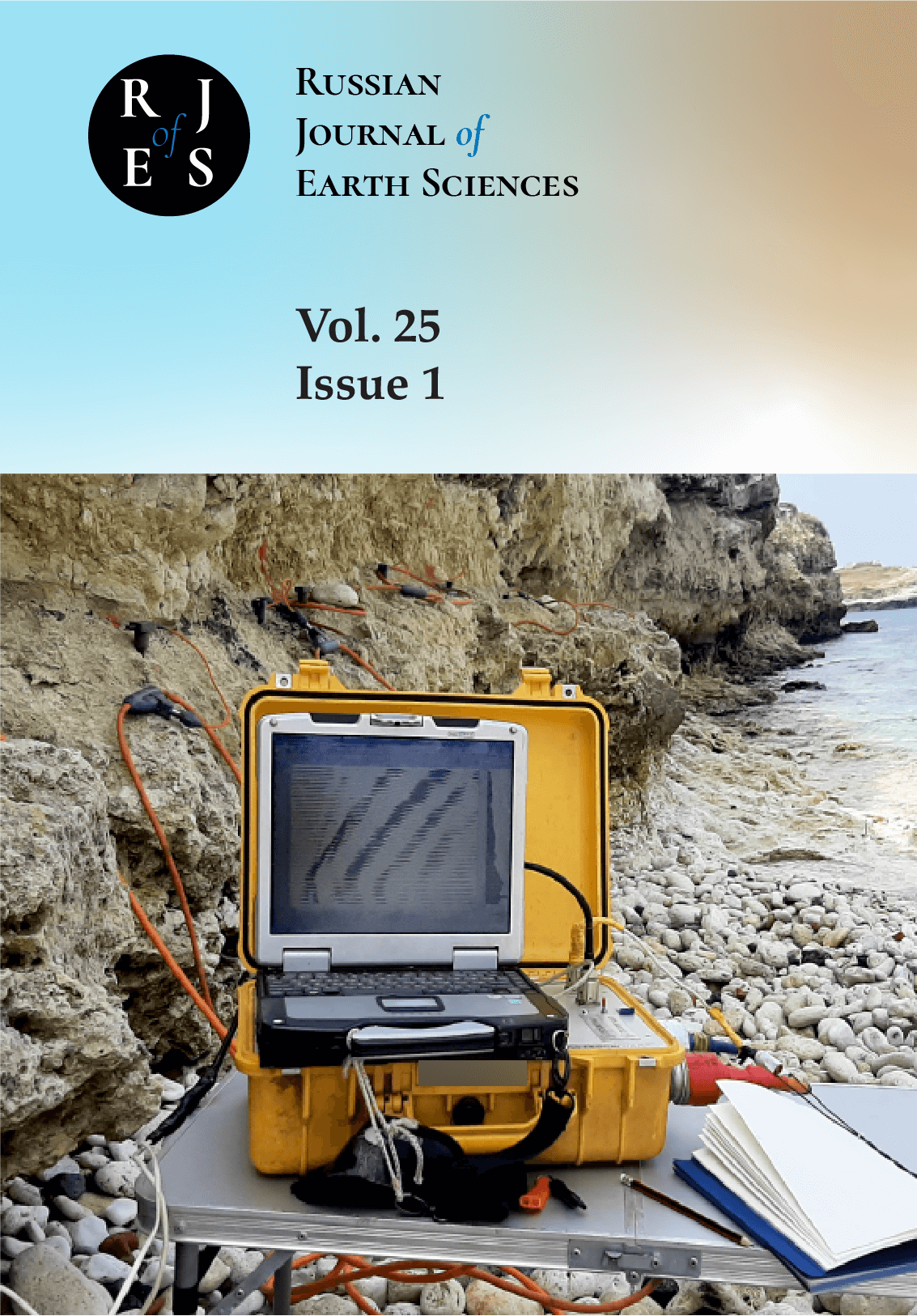сотрудник
Иркутская область, Россия
Иркутская область, Россия
Иркутская область, Россия
Иркутская область, Россия
Иркутская область, Россия
УДК 553.41 Золотые и серебряные месторождения
УДК 549.324.62 Арсенопирит
УДК 549.324.31 Пирит (железный колчедан, серный колчедан, мельниковит)
УДК 549.283 Золото
УДК 55 Геология. Геологические и геофизические науки
УДК 550.34 Сейсмология
УДК 550.383 Главное магнитное поле Земли
ГРНТИ 38.33 Геохимия
ГРНТИ 38.35 Минералогия
ГРНТИ 37.01 Общие вопросы геофизики
ГРНТИ 37.15 Геомагнетизм и высокие слои атмосферы
ГРНТИ 37.25 Океанология
ГРНТИ 37.31 Физика Земли
ГРНТИ 38.01 Общие вопросы геологии
ГРНТИ 36.00 ГЕОДЕЗИЯ. КАРТОГРАФИЯ
ГРНТИ 37.00 ГЕОФИЗИКА
ГРНТИ 38.00 ГЕОЛОГИЯ
ГРНТИ 39.00 ГЕОГРАФИЯ
ГРНТИ 52.00 ГОРНОЕ ДЕЛО
ОКСО 05.00.00 Науки о Земле
ББК 26 Науки о Земле
ТБК 63 Науки о Земле. Экология
BISAC SCI SCIENCE
The content, distribution and speciation of gold in ores of the Natalka deposit (North East Russia) were studied. According to atomic absorption spectrometry (AAS), the vein and veinlet-vein ores are highest grade in gold, whereas veinlet-disseminated ores are lower grade and disseminated ores are poor in gold. According to light microscopy and electron probe microanalysis, up to 85% of gold in the Natalka ores is represented by large and small grains of free native gold associated with gangue and sulfide minerals. The gold grains of 0.01 to 2 mm in size are dominated and their fineness vary from 720 to 860 ‰. Up to 20% of native gold is represented by finely dispersed particles < 0.01 mm in size and a fineness of 750–990‰. Most of this gold is fixed and bounded mainly to with sulfides. According to “phase” chemical analysis with AAS, arsenopyrite is richest in gold whereas pyrite is poorer in gold. Using AAS with analytical data selections for single crystals, two non-mineral forms of “invisible” gold were found in these sulfides, namely the structurally bound (structural) and surficially bound (surficial) forms. The structural gold is incorporated into the mineral structure. The surficial form is confined to nano-sized non-autonomous phases on the sulfide mineral surfaces and often dominates over the structural form. The maximum gold concentrations on the surface of arsenopyrite and pyrite were confirmed by LA-ICP-MS data. It is expected that not all “invisible” gold is a refractory gold. The major part of gold contained in arsenopyrite and pyrite as finely dispersed, micron- and submicron-sized particles, as well as the surficially bound gold, can be extracted with modification of current flowsheet, which enhances the value of the gold ores at the Natalka deposit.
Natalka deposit, gold, ores, content, distribution, gangue minerals, sulfide minerals, arsenopyrite, pyrite, speciation
1. Akimov, V. V., D. N. Babkin, and O. Y. Belozerova (2024), Behavior of Gold Nanoparticles at the Interphase Boundary of Quartz-Selenide Copper and Iron at a Temperature of 450 ◦C and Different Selenium Activity, Russian Geology and Geophysics, 65(8), 910–926, https://doi.org/10.2113/rgg20244691. EDN: https://elibrary.ru/TQKNFD
2. Barker, S. L. L., K. A. Hickey, J. S. Cline, et al. (2009), Uncloaking invisible gold: use of nanosims to evaluate gold, trace elements, and sulfur isotopes in pyrite from Carlin-type gold deposits, Economic Geology, 104(7), 897–904, https://doi.org/10.2113/econgeo.104.7.897.
3. Bortnikov, N. S., I. A. Bryzgalov, N. N. Krivitskaya, et al. (2004), The Maiskoe Multimegastage Disseminated Gold-Sulfide Deposit (Chukotka, Russia): Mineralogy, Fluid Inclusions, Stable Isotopes (O and S), History, and Conditions of Formation, Geology of Ore Deposits, 46(6), 409–440. EDN: https://elibrary.ru/LIUGYP
4. Cabri, L. J., S. L. Chryssoulis, J. P. R. De Villiers, et al. (1989), The nature of “invisible” gold in arsenopyrite, The Canadian Mineralogist, 27(3), 353–362.
5. Cambel, B., V. Streško, and O. Šherenčáaková (1980), The contents of gold in pyrites of various genesis, Geologický Zbornik - Geologica Carpathica, 31(1–2), 139–159.
6. Cook, N. J., and S. L. Chryssoulis (1990), Concentrations of “invisible gold” in the common sulfides, The Canadian Mineralogist, 28(1), 1–16.
7. Ehrig, K., C. L. Ciobanu, M. R. Verdugo-Ihl, et al. (2023), Lifting the cloak of invisibility: Gold in pyrite from the Olympic Dam Cu-U-Au-Ag deposit, South Australia, American Mineralogist, 108(2), 259–276, https://doi.org/10.2138/am-2022-8395. EDN: https://elibrary.ru/MSUDGG
8. Finkelshtein, A. L., V. V. Tatarinov, E. A. Finkelstein, et al. (2018), About the assessment of gold concentrations in tiny inclusions within sulfide mineral matrix: An electron microprobe study, X-Ray Spectrometry, 47(6), 423–431, https://doi.org/10.1002/xrs.2967. EDN: https://elibrary.ru/UNOJEY
9. Fleet, M. E., and A. H. Mumin (1997), Gold-bearing arsenian pyrite and marcasite and arsenopyrite from Carlin Trend gold deposits and laboratory synthesis, American Mineralogist, 82(1–2), 182–193, https://doi.org/10.2138/am-1997-1-220.
10. Fougerouse, D., S. M. Reddy, D. W. Saxey, et al. (2016), Nanoscale gold clusters in arsenopyrite controlled by growth rate not concentration: Evidence from atom probe microscopy, American Mineralogist, 101(8), 1916–1919, https://doi.org/10.2138/am-2016-5781ccbyncnd. EDN: https://elibrary.ru/WSVTJZ
11. Fridovsky, V. Y., L. I. Polufuntikova, and M. V. Kudrin (2022), Geochemical and Isotopic Characteristics of Disseminated Sulfide Mineralization of Orogenic Gold Deposits of the Yana-Kolyma Metallogenic Belt, Northeast Russia, Doklady Earth Sciences, 507(S2), S240–S246, https://doi.org/10.1134/s1028334x2260102x. EDN: https://elibrary.ru/XXLVLM
12. Gao, F. P., Y. S. Du, Z. S. Pang, et al. (2019), LA-ICP-MS Trace-Element Analysis of Pyrite from the Huanxiangwa Gold Deposit, Xiong’ershan District, China: Implications for Ore Genesis, Minerals, 9(3), 157, https://doi.org/10.3390/min9030157. EDN: https://elibrary.ru/AHEVTZ
13. Genkin, A. D., N. S. Bortnikov, L. J. Cabri, et al. (1998), A multidisciplinary study of invisible gold in arsenopyrite from four mesothermal gold deposits in Siberia, Russian Federation, Economic Geology, 93(4), 463–487, https://doi.org/10.2113/gsecongeo.93.4.463. EDN: https://elibrary.ru/LERQQZ
14. Goncharov, V. I., S. V. Voroshin, and V. A. Sidorov (2002), Natalka Gold Lode Deposit, 250 pp., NEISRI FEB RAS (in Russian).
15. Goryachev, N. A., V. A. Sidorov, I. S. Litvinenko, and T. I. Mikhalitsyna (2000), Mineral composition and petrogeochemical features of ore zones of deep horizons of the Natalka deposit, Kolyma, (2), 38–49 (in Russian).
16. Goryachev, N. A., O. V. Vikent’eva, N. S. Bortnikov, et al. (2008), The world-class Natalka gold deposit, northeast Russia: REE patterns, fluid inclusions, stable oxygen isotopes, and formation conditions of ore, Geology of Ore Deposits, 50(5), 362–390, https://doi.org/10.1134/s1075701508050024. EDN: https://elibrary.ru/LLGXKX
17. Goryachkin, N. I., V. A. Chinenov, and V. L. Khoroshilov (1999), Mineralogical characteristics of gold lost during ore processing at the Natalka deposit (North-East of Russia), Proceedings of higher educational establishments. Geology and Exploration, (5), 95–102 (in Russian).
18. Grigorov, S. A., V. D. Vorozhbenko, P. I. Kushnarev, et al. (2007), Geology and key signatures of the Natalka gold deposit, Domestic Geology, (3), 43–50 (in Russian), EDN: https://elibrary.ru/IAAXZN.
19. Herrington, R. J., and J. J. Wilkinson (1993), Colloidal gold and silica in mesothermal vein systems, Geology, 21(6), 539–542, https://doi.org/10.1130/0091-7613(1993)021<0539:CGASIM>2.3.CO;2.
20. Hough, R. M., R. R. P. Noble, and M. Reich (2011), Natural gold nanoparticles, Ore Geology Reviews, 42(1), 55–61, https://doi.org/10.1016/j.oregeorev.2011.07.003. EDN: https://elibrary.ru/PHRONN
21. Koneev, R. I., R. A. Khalmatov, and A. N. Krivosheeva (2020), Finding forms and Micro- and Nanoscale Assemblages of Gold as Indicators of Formation Conditions, Distribution, and Typification of Orogenic Deposits of Uzbekistan (South Tien Shan), Geology of Ore Deposits, 62(8), 731–742, https://doi.org/10.1134/s1075701520080061.
22. Kravtsova, R. G. (2010), Geochemistry and Forming Conditions of Gold-Silver Ore-Forming Systems, Northern Pre Okhotsk Region, 292 pp., Geo, Novosibirsk (in Russian), EDN: https://elibrary.ru/QKJONH.
23. Kravtsova, R. G., and L. A. Solomonova (1985), Gold in Pyrite from Ores and Metasomatites of the Gold-Silver Deposits in the North Okhot’ye Volcanogenic Fields, Geochemistry International, 22(5), 9–14.
24. Kravtsova, R. G., V. L. Tauson, and E. M. Nikitenko (2015), Modes of Au, Pt, and Pd occurrence in arsenopyrite from the Natalkinskoe deposit, NE Russia, Geochemistry International, 53(11), 964–972, https://doi.org/10.1134/s0016702915090037. EDN: https://elibrary.ru/UZZWST
25. Kravtsova, R. G., V. L. Tauson, N. A. Goryachev, et al. (2020a), SEM Study of the Surface of Arsenopyrite and Pyrite from the Natalkinskoe Deposit, Northeastern Russia, Geochemistry International, 58(5), 531–538, https://doi.org/10.1134/s0016702920050031. EDN: https://elibrary.ru/UFIQZO
26. Kravtsova, R. G., V. L. Tauson, A. S. Makshakov, et al. (2020b), Platinum Group Elements in Arsenopyrites and Pyrites of the Natalkinskoe Gold Deposit (Northeastern Russia), Minerals, 10(4), 318, https://doi.org/10.3390/min10040318. EDN: https://elibrary.ru/GTYOWZ
27. Kravtsova, R. G., A. S. Makshakov, V. L. Tauson, et al. (2022), Speciation Features of Gold in Ores And Minerals of the Natalkinskoe Deposit (North-East Russia), Geodynamics & Tectonophysics, 13(2), https://doi.org/10.5800/gt-2022-13-2s-0595 (in Russian).
28. Large, R. R., and V. V. Maslennikov (2020), Invisible Gold Paragenesis and Geochemistry in Pyrite from Orogenic and Sediment-Hosted Gold Deposits, Minerals, 10(4), 339, https://doi.org/10.3390/min10040339. EDN: https://elibrary.ru/YTALOB
29. Large, R. R., L. Danyushevsky, C. Hollit, et al. (2009), Gold and Trace Element Zonation in Pyrite Using a Laser Imaging Technique: Implications for the Timing of Gold in Orogenic and Carlin-Style Sediment-Hosted Deposits, Economic Geology, 104(5), 635–668, https://doi.org/10.2113/gsecongeo.104.5.635. EDN: https://elibrary.ru/MWZMFX
30. Li, C. P., J. F. Shen, S. R. Li, et al. (2019), In-Situ LA-ICP-MS Trace Elements Analysis of Pyrite and the Physicochemical Conditions of Telluride Formation at the Baiyun Gold Deposit, North East China: Implications for Gold Distribution and Deposition, Minerals, 9(2), 129, https://doi.org/10.3390/min9020129. EDN: https://elibrary.ru/RAYYZC
31. Liang, Y. Y., L. Shu, P. Y. Ma, et al. (2023), Gold source and ore-forming process of the Linglong gold deposit, Jiaodong gold province, China: Evidence from textures, mineral chemical compositions and sulfur isotopes of pyrite, Ore Geology Reviews, 159, 105523, https://doi.org/10.1016/j.oregeorev.2023.105523.
32. Litvinenko, I. S. (2009), The conditions of existence and typomorphism of native gold in ores of the Degdekanskoe deposit (northeastern Russia) in black-shale strata, Russian Geology and Geophysics, 50(6), 535–540, https://doi.org/10.1016/j.rgg.2008.10.003. EDN: https://elibrary.ru/KHYBUS
33. Liu, J. C., Y. T. Wang, S. K. Huang, et al. (2019), The gold occurrence in pyrite and Te-Bi mineralogy of the Fancha gold deposit, Xiaoqinling gold field, southern margin of the North China Craton: Implication for ore genesis, Geological Journal, 55(8), 5791–5811, https://doi.org/10.1002/gj.3637. EDN: https://elibrary.ru/VBWTEY
34. Method NSAM No. 237-S (2016), Gold Determination in Rocks, Ores and Their Processed Products used Extraction-AtomicAbsorption Method with Organic Sulfides, 18 pp., VIMS, Moscow (in Russian).
35. Mikhalitsyna, T. I., and O. T. Sotskaya (2020), The Role of Black-Shale Strata in the Formation of the Natalka and Pavlik Gold Deposits (Yana-Kolyma Orogenic Belt), Russian Geology and Geophysics, 61(12), 1354–1373, https://doi.org/10.15372/rgg2020149. EDN: https://elibrary.ru/PBTXOR
36. Moiseenko, V. G., and I. V. Kuznetsova (2010), The role of gold, silver, and lead nanoparticles in the formation of deposits of precious metals, Doklady Earth Sciences, 430(1), 125–128, https://doi.org/10.1134/s1028334x10010277. EDN: https://elibrary.ru/MXLZLH
37. Morishita, Y., N. Shimada, and K. Shimada (2018), Invisible gold in arsenian pyrite from the high-grade Hishikari gold deposit, Japan: Significance of variation and distribution of Au/As ratios in pyrite, Ore Geology Reviews, 95, 79–93, https://doi.org/10.1016/j.oregeorev.2018.02.029. EDN: https://elibrary.ru/YHKNLN
38. Moskvitin, S. G., L. V. Moskvitina, and V. I. Popov (2023), Morphology and localization of nanoscale gold in the sulphides of the gold-sulphide deposit situated in the black shale strata of the Northern Verkhoyanye in Yakutia, Tsvetnye Metally, (3), 13–19, https://doi.org/10.17580/tsm.2023.03.02 (in Russian). EDN: https://elibrary.ru/TEDLGY
39. Novozhilov, Y. I., and A. M. Gavrilov (1999), Gold-sulfide deposits in terrigenous carbonaceous strata, 220 pp., TsNIGRI, Moscow (in Russian).
40. Palenik, C. S., S. Utsunomiya, M. Reich, et al. (2004), “Invisible” gold revealed: Direct imaging of gold nanoparticles in a Carlin-type deposit, American Mineralogist, 89(10), 1359–1366, https://doi.org/10.2138/am-2004-1002. EDN: https://elibrary.ru/LSURRL
41. Pals, D. W., P. G. Spry, and S. Chryssoulis (2003), Invisible Gold and Tellurium in Arsenic-Rich Pyrite from theEmperor Gold Deposit, Fiji: Implications for Gold Distribution and Deposition, Economic Geology, 98(3), 479–493, https://doi.org/10.2113/gsecongeo.98.3.479. EDN: https://elibrary.ru/JRDYWX
42. Pavlova, L. A. (2014), The Electron Probe X-Ray Microanalysis and Its Utilization, 294 pp., LAP LAMBERT Academic Publishing, Saarbrucken (in Russian).
43. Plyusnina, L. P., A. I. Khanchuk, V. I. Goncharov, et al. (2003), Gold, platinum, and palladium in ores of the Natalka deposit, Upper Kolyma Region, Doklady Earth Sciences, 391(6), 836–340. EDN: https://elibrary.ru/LIFODD
44. Prokofiev, V. Y., D. A. Banks, K. V. Lobanov, et al. (2020), Exceptional Concentrations of Gold Nanoparticles in 1,7 Ga Fluid Inclusions From the Kola Superdeep Borehole, Northwest Russia, Scientific Reports, 10(1), 1108, https://doi.org/10.1038/s41598-020-58020-8. EDN: https://elibrary.ru/ETWVHA
45. Saunders, J. A., and P. A. Schoenly (1995), Boiling, colloid nucleation and aggregation, and the genesis of bonanza Au-Ag ores of the sleeper deposit, Nevada, Mineralium Deposita, 30(3–4), 199–210, https://doi.org/10.1007/bf00196356. EDN: https://elibrary.ru/WTCSRW
46. Savva, N. E., R. G. Kravtsova, G. S. Anisimova, and G. A. Palyanova (2022), Typomorphism of Native Gold (GeologicalIndustrial Types of Gold Deposits in the North-East of Russia), Minerals, 12(5), 561, https://doi.org/10.3390/min12050561. EDN: https://elibrary.ru/ANIYRM
47. Shao, Y. J., W. S. Wang, Q. Q. Liu, and Y. Zhang (2018), Trace Element Analysis of Pyrite from the Zhengchong Gold Deposit, Northeast Hunan Province, China: Implications for the Ore-Forming Process, Minerals, 8(6), 262, https://doi.org/10.3390/min8060262. EDN: https://elibrary.ru/YJPDLN
48. Sidorova, N. V., V. V. Aristov, A. V. Grigor’eva, and A. A. Sidorov (2020), “Invisible” Gold in Pyrite and Arsenopyrite from The Pavlik Deposit (Northeastern Russia), Doklady Earth Sciences, 495(1), 821–826, https://doi.org/10.1134/s1028334x20110136. EDN: https://elibrary.ru/YSVVYT
49. Sidorova, N. V., A. V. Volkov, E. V. Kovalchuk, et al. (2022), Invisible Gold and Other Impurity Elements in Pyrite and Arsenopyrite of Disseminated Ores of the Kyuchus Deposit (Sakha Republic (Yakutia)), Geology of Ore Deposits, 64(5), 281–291, https://doi.org/10.1134/s1075701522040067. EDN: https://elibrary.ru/FCPDLN
50. Simon, G., S. E. Kesler, and S. Chryssoulis (1999), Geochemistry and textures of gold-bearing arsenian pyrite, Twin Creeks, Nevada; implications for deposition of gold in carlin-type deposits, Economic Geology, 94(3), 405–421, https://doi.org/10.2113/gsecongeo.94.3.405.
51. Tan, H. J., Y. J. Shao, Q. Q. Liu, et al. (2022), Textures, trace element geochemistry and in-situ sulfur isotopes of pyrite from the Xiaojiashan gold deposit, Jiangnan Orogen: Implications for ore genesis, Ore Geology Reviews, 144, 104843, https://doi.org/10.1016/j.oregeorev.2022.104843. EDN: https://elibrary.ru/MHKRYH
52. Tauson, V. L., and E. K. Lustenberg (2008), Quantitative determination of modes of gold occurrence in minerals by the statistical analysis of analytical data samplings, Geochemistry International, 46(4), 423–428, https://doi.org/10.1134/s0016702908040101. EDN: https://elibrary.ru/LLKRQJ
53. Tauson, V. L., O. I. Bessarabova, R. G. Kravtsova, et al. (2002), Determination of binding forms of gold in pyrite by means of statistical analysis, Russian Geology and Geophysics, 43(1), 56–64.
54. Tauson, V. L., R. G. Kravtsova, V. I. Grebenshchikova, et al. (2009), Surface typochemistry of hydrothermal pyrite: Electron spectroscopic and scanning probe microscopic data. II. Natural pyrite, Geochemistry International, 47(3), 231–243, https://doi.org/10.1134/s0016702909030021. EDN: https://elibrary.ru/LLRXHF
55. Tauson, V. L., D. N. Babkin, T. M. Pastushkova, et al. (2011), Dualistic distribution coefficients of elements in the system mineral-hydrothermal solution. I. Gold accumulation in pyrite, Geochemistry International, 49(6), 568–577, https://doi.org/10.1134/s0016702911060097. EDN: https://elibrary.ru/OHTLQR
56. Tauson, V. L., D. N. Babkin, V. V. Akimov, et al. (2013), Trace elements as indicators of the physicochemical conditions of mineral formation in hydrothermal sulfide systems, Russian Geology and Geophysics, 54(5), 526–543, https://doi.org/10.1016/j.rgg.2013.04.005. EDN: https://elibrary.ru/RFGRZJ
57. Tauson, V. L., R. G. Kravtsova, N. V. Smagunov, et al. (2014), Structurally and superficially bound gold in pyrite from deposits of different genetic types, Russian Geology and Geophysics, 55(2), 273–289, https://doi.org/10.1016/j.rgg.2014.01.011. EDN: https://elibrary.ru/SKLMML
58. Tauson, V. L., S. V. Lipko, N. V. Smagunov, and R. G. Kravtsova (2018a), Trace Element Partitioning Dualism under Mineral-Fluid Interaction: Origin and Geochemical Significance, Minerals, 8(7), 282, https://doi.org/10.3390/min8070282. EDN: https://elibrary.ru/YBUUHB
59. Tauson, V. L., S. V. Lipko, N. V. Smagunov, et al. (2018b), Distribution and segregation of trace elements during the growth of ore mineral crystals in hydrothermal systems: geochemical and mineralogical implications, Russian Geology and Geophysics, 59(12), 1718–1732, https://doi.org/10.1016/j.rgg.2018.12.013. EDN: https://elibrary.ru/UTBELY
60. Tauson, V. L., S. V. Lipko, R. G. Kravtsova, et al. (2019), Distribution of “Invisible” Noble Metals between Pyrite and Arsenopyrite Exemplified by Minerals Coexisting in Orogenic Au Deposits of North-Eastern Russia, Minerals, 9(11), 660, https://doi.org/10.3390/min9110660. EDN: https://elibrary.ru/JYSBDR
61. Volkov, A. V., A. D. Genkin, and V. I. Goncharov (2006), The forms of the presence of gold in the ores of the Natalka and May deposits (Northeast Russia), Tikhookeanskaya Geologiya, 25(6), 18–29 (in Russian), EDN: https://elibrary.ru/JJYBLZ.
62. Volkov, A. V., A. A. Sidorov, N. E. Savva, et al. (2016), Orogenic Gold Deposits of the Yana-Kolyma Fold Belt: Ore and Fluid Geochemical Peculiarities, Ore Formation Conditions, The Bulletin of the North-East Scientific Center, (3), 3–21 (in Russian), EDN: https://elibrary.ru/WZWVIV.
63. Wells, J. D., and T. E. Mullens (1973), Gold-Bearing Arsenian Pyrite Determined by Microprobe Analysis, Cortez and Carlin Gold mines, Nevada, Economic Geology, 68(2), 187–201, https://doi.org/10.2113/gsecongeo.68.2.187.
64. Zhang, J., J. Deng, H. Y. Chen, et al. (2014), LA-ICP-MS trace element analysis of pyrite from the Chang’an gold deposit, Sanjiang region, China: Implication for ore-forming process, Gondwana Research, 26(2), 557–575, https://doi.org/10.1016/j.gr.2013.11.003. EDN: https://elibrary.ru/UROYSL
65. Zhao, H. X., H. E. Frimmel, S. Y. Jiang, and B. Z. Dai (2011), LA-ICP-MS trace element analysis of pyrite from the Xiaoqinling gold district, China: Implications for ore genesis, Ore Geology Reviews, 43(1), 142–153, https://doi.org/10.1016/j.oregeorev.2011.07.006. EDN: https://elibrary.ru/PHROOH

















